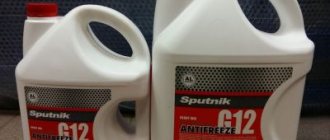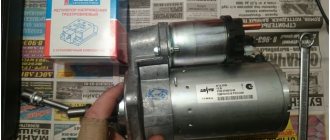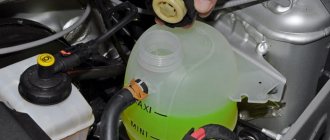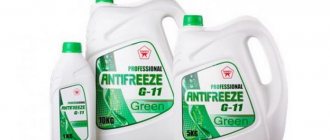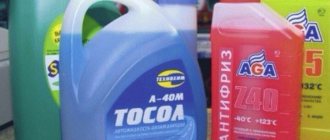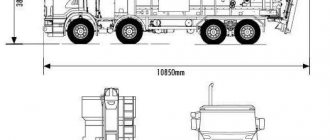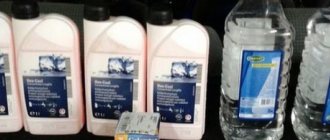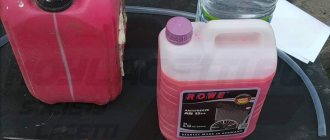Without coolant, the engine will not be able to function for more than a few tens of minutes. Therefore, in the event of a sudden antifreeze leak, you will have to replenish the minimum coolant supply in order to continue driving. But it is not always possible to choose the antifreeze recommended by the car manufacturer. Below we will try to figure out whether it is possible to mix G12 and G12+ antifreezes.
What is special about G12 antifreeze
service life compared to antifreeze or antifreeze G11 . G12 does not contain silicates; it is based on ethylene glycol and carboxylate compounds. Thanks to the additive package, on the surface inside the block or radiator, corrosion is localized only where necessary, forming a resistant micro film. Often this type of antifreeze is poured into the cooling system of high-speed engines. Mixing g12 antifreeze and coolant of another class is unacceptable .
But it has one big disadvantage - G12 antifreeze begins to act only when a source of corrosion has already appeared. Although this action prevents the appearance of a protective layer and its rapid shedding as a result of vibrations and temperature changes, which makes it possible to improve heat transfer and longer use.
How to spot a fake
To avoid buying a fake by mistake, you need to know what signs will help you distinguish the original antifreeze.
- First of all, this is quality, it should be visible in everything. The plastic of the canister is dense and smooth, without defects, chips or signs of opening. The seams are even and smooth. The lid is tightly connected to the protective ring. The labels are glued smoothly, without folds, bubbles or glue drips.
- Secondly, this is information. It must be applied to the labels efficiently (without errors, not smeared, not erased) and contain the necessary minimum information about the product. This is the product code (article), date of manufacture and bottling, specifications, composition, standard, recommendations for use, address and telephone number of the manufacturer.
When purchasing, you should ask the seller to show a quality certificate - all original products have one.
Main technical characteristics of class G12
It is a homogeneous transparent liquid without mechanical impurities of red or pink color. Antifreeze G12 is ethylene glycol with the addition of 2 or more carboxylic acids; it does not form a protective film, but affects already formed areas of corrosion. Density is 1.065 – 1.085 g/cm3 (at 20°C). The freezing point is within 50 degrees below zero, and the boiling point is about +118°C. Temperature characteristics depend on the concentration of polyhydric alcohols (ethylene glycol or propylene glycol). Often, the percentage of such alcohol in antifreeze is 50-60%, which allows for optimal performance. Pure, without any impurities, ethylene glycol is a viscous and colorless oily liquid with a density of 1114 kg/m3 and has a boiling point of 197°C, and freezes at 13°C. Therefore, dye is added to antifreeze to give it individuality and greater visibility of the liquid level in the tank. Ethylene glycol is a strong food poison, the effect of which can be neutralized with ordinary alcohol.
Remember that coolant is deadly to the body. To cause death, 100-200 g of ethylene glycol will be enough. Therefore, antifreeze should be hidden as far as possible from children, because the bright color, similar to a sweet drink, is of great interest to them.
What does boiling point affect?
First of all, the boiling point affects the viscosity of the substance and the decomposition of the additive package designed to protect the cooling system from corrosion. In fact, it also destroys antifreeze and the freezing threshold, which for pure red antifreeze without additives is only -13 degrees. Accordingly, it is impossible to use some solutions in cold weather, for which purpose special coolant concentrates are created, which are diluted independently, following the instructions on the packaging.
By the way, open concentrate cannot be stored for a long time, and the average service life of high-quality red antifreeze can be from three to five years in a working environment, so the purchase of four-liter canisters with concentrated solutions is absolutely not justified.
And yet, the situation when red antifreeze boils is practically zero. This can only be due to a malfunction of the cooling system or a serious breakdown of the power unit itself, although low-quality coolant cannot be ruled out either. Such compounds may simply contain water tinted to the desired color, then the boiling limit will occur at 100 degrees, which will be safely reported by the temperature sensor starting from the red zone of 90 degrees.
One more nuance: high-quality red antifreezes of class G-12 and G-12+ work most effectively in the red zone, so this is not a reason to stop the car and wait until it cools down. It is for such situations that they are created, having their own boiling threshold of over 100 degrees and a more viscous structure than ethylene glycol G-11. Again, the latter work differently to boil; the protective film initially created by the compound also prevents overheating of parts, successfully removing excess heat, but it collapses much faster than the viscous composition of propylene glycols.
In conclusion, it is worth saying that red antifreeze is a symbol for coolant, and it must be selected solely from the point of view of the composition and recommendations of the car manufacturer, who took into account all the nuances of the effects of reagents on the cooling system and other systems adjacent to it.
What does G12 antifreeze consist of?
The G12 class antifreeze concentrate includes:
- dihydric alcohol ethylene glycol about 90% of the total volume, which is needed to prevent freezing;
- distilled water , about five percent;
- dye (color often identifies the class of coolant, but there may be exceptions);
- additive package of at least 5 percent, since ethylene glycol is aggressive towards non-ferrous metals, several types of phosphate or carboxylate additives based on organic acids are added to it, acting as an inhibitor to neutralize the negative impact. Antifreezes with different sets of additives perform their functions differently, and their main difference is in the methods of combating corrosion.
In addition to corrosion inhibitors, the set of additives in the G12 coolant includes additives with other necessary properties. For example, the coolant must have anti-foaming, lubricants and compounds that prevent the appearance of scale.
What is the difference between G12 and G11, G12+ and G13
The main types of antifreeze, such as G11, G12 and G13, differ in the type of additives used: organic and inorganic.
General information about antifreeze, what is the difference between them and how to select the right coolant
Coolant class G11 of inorganic origin with a small set of additives, the presence of phosphates and nitrates. This antifreeze is created using silicate technology. Silicate additives cover the internal surface of the system with a continuous protective layer, regardless of the presence of corrosion areas. Although such a layer protects existing areas of corrosion from destruction . Such antifreeze has low stability, poor heat transfer and a short service life; after production, it precipitates, forming an abrasive and thereby damaging the elements of the cooling system.
Due to the fact that G11 antifreeze creates a layer similar to scale in a kettle, it is not suitable for cooling modern cars with radiators with thin channels. In addition, the boiling point of such a cooler is 105 ° C, and the service life is no more than 2 years or 50-80 thousand km. mileage
Often, G11 antifreeze is colored green or blue . This coolant is used for cars manufactured before 1996 and cars with a large cooling system.
G11 is not well suited to aluminum radiators and blocks, as its additives cannot properly protect this metal at high temperatures.
In Europe, the authoritative specification of antifreeze classes belongs to the Volkswagen concern, therefore the corresponding marking VW TL 774-C provides for the use of inorganic additives in antifreeze and is designated G 11. The VW TL 774-D specification provides for the presence of organic-based carboxylic acid additives and is marked as G 12. VW standards TL 774-F and VW TL 774-G are marked with classes G12 + and G12 ++, and the most complex and expensive antifreeze G13 is regulated by the VW TL 774-J standard. Although other manufacturers such as Ford or Toyota have their own quality standards. By the way, there is no difference between antifreeze and antifreeze. Antifreeze is one of the brands of Russian mineral antifreeze, which is not designed to work in engines with an aluminum block.
It is strictly forbidden to mix organic and inorganic antifreezes, since a coagulation process will occur and as a result a sediment in the form of flakes will appear!
And liquids of classes G12, G12 + and G13 are varieties of organic antifreeze “Long Life”. They are used in cooling systems of modern cars produced since 1996. G12 and G12 + are based on ethylene glycol, but only G12 plus involves the use of hybrid production technology, which combines silicate technology with carboxylate technology. In 2008, the G12++ class also appeared; this liquid has an organic base combined with a small amount of mineral additives (called lobrid Lobrid or SOAT coolants). In hybrid antifreezes, organic additives are mixed together with inorganic ones (silicates, nitrites and phosphates can be used). This combination of technologies made it possible to eliminate the main drawback of G12 antifreeze - not only eliminate corrosion when it has already appeared, but also perform a preventive effect.
G12+, unlike G12 or G13, can be mixed with liquid class G11 or G12, but still such a “mix” is not recommended.
Coolant class G13 began to be produced in 2012 and is designed for automobile engines operating in extreme conditions . From a technological point of view, it is no different from G12, the only difference is that it is made with propylene glycol , which is less toxic, decomposes faster, and therefore causes less harm to the environment when disposed of and its price is significantly higher than G12 antifreeze. It was invented based on the requirements for increasing environmental standards. G13 antifreeze is usually purple or pink, although in fact it can be painted in any color, since it is just a dye on which its characteristics do not depend; different manufacturers can produce coolant with different colors and shades.
The difference in the action of carboxylate and silicate antifreezes
G12 antifreeze compatibility
Is it possible to mix antifreezes of different classes and different colors? Quite a lot of inexperienced car owners who have purchased a used car and do not know what brand of coolant was poured into the expansion tank are interested.
If you only need to add antifreeze, then you should know exactly what is currently poured into the system, otherwise you risk having to repair not only the cooling system, but also the repair of the entire unit. It is recommended that you completely drain the old fluid and fill it with new one.
As we already figured out earlier, color does not affect the property, and different manufacturers can paint in different colors, but still, there are generally accepted standards . The most common antifreeze colors are green, blue, red, pink and orange. Some standards may even regulate the use of liquids of certain shades, but the color of antifreeze is the last criterion that should be taken into account. Although, it is often customary to designate green as the liquid of the lowest class G11 (silicate) . Therefore, say, mixing red and pink G12 antifreeze (carboxylate) is allowed, as well as antifreezes only on an organic basis or liquids only on an inorganic basis, but you need to know that different ones may have a different set of additives and chemicals. substances whose reactions cannot be predicted! This incompatibility of G12 antifreeze means there is a high probability that a reaction may occur between the additives included in their composition, which will be accompanied by precipitation or deterioration of the technical characteristics of the coolant.
Therefore, if you want to maintain engine performance, fill in antifreeze of the same brand and class, or completely drain the old fluid and replace it with a known one. A small addition of liquid can be done with distilled water .
If you want to switch from one class of antifreeze to another, then you should also flush the cooling system before replacing.
Is it possible to mix
It should be noted right away that you should not experiment with this at random. It is best to always use the class of antifreeze recommended by the manufacturer and fill it with that. Many drivers allow mixing liquids of the same color, but, as already mentioned, you cannot be guided by color alone.
Antifreezes can be mixed with each other if they belong to the same class. For example, blue and green G11, which also includes the well-known TOSOL.
Mixing different classes, say G11 with G12, needs to be done with great caution, although there may not be anything critical. A lot depends on the ratio. Different additives will affect the composition of the liquid, which will accordingly affect its properties. But the G12++ class can be mixed with G11 or G12, G12+.
The same applies to G13, which can be mixed with most other coolants, since it is essentially G12++, only safe. Antifreeze compatibility can be seen in the following figure.
Mixing antifreeze
When choosing antifreeze, you should first of all focus on the manufacturer’s recommendations specifically for your car and take into account the materials from which the engine is made. You should not experiment with the composition by mixing different categories. Color may indicate the class of liquid, but not always accurately.
Which antifreeze to choose
When the question concerns the choice of antifreeze not only by color, but also by class, then it is recommended to use the one that the manufacturer indicates on the expansion tank or technical documentation of the car. Because if copper or brass was used in the manufacture of the cooling radiator (installed on older cars), then the use of organic antifreeze is undesirable.
Antifreeze can be of 2 types: concentrated and already diluted at the factory. At first glance, there doesn’t seem to be much difference, and many car enthusiasts advise taking the concentrate and then diluting it with distilled water, only observing the proportion (1 to 1 for our climatic conditions), explaining this by saying that what you are pouring is not a fake , but unfortunately, taking concentrate is not entirely correct. Not only because mixing at the plant occurs more accurately, but also because the water at the plant is filtered at the molecular level and distilled water seems dirty in comparison, so this can subsequently affect the appearance of deposits.
The concentrate cannot be used in its pure undiluted form, because it itself freezes at -12 degrees.
